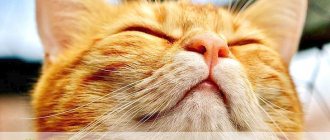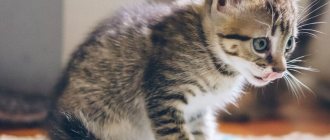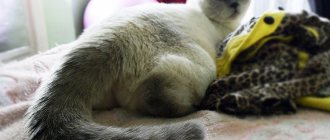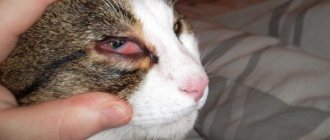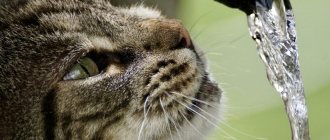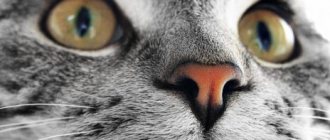Sneezing is a natural physiological process that allows you to clear your nose of foreign bodies (dust, pollen, etc.). It could also be a reaction to a strong odor. If the cat feels well - plays, eats - and the sneezing was a one-time event, then in this case there is no need to sound the alarm.
And it happens that a cat sneezes often, with discharge from the nose. Murkoshi specialists draw your attention to the fact that such sneezing can accompany infectious diseases, including those dangerous to humans. Let's figure out in what cases a cat sneezes and what to do about it.
1) Causes of sneezing
2) When should you consult a doctor?
3) Pet treatment
4) Prevention of sneezing
Main reasons
Why does a domestic cat sneeze? An absolutely healthy pet does not sneeze so often, usually 1-2 times a day or about 5 times a week.
Severe pathology is sneezing more than 2 times a day, cascading sneezing, various substances discharged from the nose, the presence of associated symptoms - coughing, wheezing, refusal to eat, lethargy, high fever.
Reasons that can cause a cat to sneeze
The reasons why a cat sneezes often are varied. First, it is necessary to clearly determine that several sneezes a day are not a sign of illness. The sneezing reflex appears as a result of irritation of the mucous membrane by particles of dust or sand.
If your cat is constantly sneezing and is in unsatisfactory condition, you should sound the alarm.
You should contact a veterinary hospital if sneezing is accompanied by apathy and weakness of the animal, refusal to eat, lacrimation and an increase in body temperature.
The basic reasons are:
- Allergic type reaction. Allergies in cats are diagnosed quite often and are accompanied by the cat sneezing and her eyes watering. Allergies develop against the background of inhalation of dust particles, pollen from flowering plants, smoke, aromatic compositions, and air fresheners. Symptoms of allergies, in addition to sneezing, are changes in the skin (rash and itching), eruption of gastric contents, and breathing problems.
- Colds. When a cat has a cold and sneezes, the main reason is a sharp decrease in the body's defenses due to hypothermia. As a result of colds, discharge from the nasal passages is noted, body temperature increases, and a cough develops.
- Diseases of an infectious nature. Various pathogenic bacterial microorganisms, fungi and viral agents provoke a lot of diseases. Infections in the nasal passages are characterized by the fact that the cat constantly sneezes, the body temperature changes, there is a cough and refusal to eat, a specific secretion is actively released from the nasal passages, and the general condition of the animal is depressed. With some infections of viral etiology, dyspeptic disorders are observed (eruption of gastric contents, diarrhea), and the mucous membrane of the eyes becomes inflamed. In advanced cases, the cat sneezes blood.
- Foreign objects in the nasal passages. Cats are quite curious, especially when they are young. Various foreign objects that enter the nasal passages during sniffing can provoke serious changes in the body. Trying to get rid of a foreign body, the animal sneezes, snot appears (sometimes with blood impurities when the integrity of the mucous membrane of the nasal passages is damaged). Serious damage is characterized by the cat's heavy breathing and severe anxiety.
- Proliferation of polyps in the nasal passages. Neoplasms in the nasal cavity, such as polyposis, lead to the development of regular bouts of sneezing. In addition, signs of nasal polyps are nasal discharge and the cat's characteristic wheezing when breathing.
- Bronchial asthma. Attacks of diseases of the bronchial tree, the mucous membranes become noticeably pale, sometimes characterized by cyanosis. In addition, the animal makes characteristic swallowing movements and becomes apathetic. Breathing is hoarse and whistling.
- Worm infestations. If your cat has a runny nose, helminths may be the cause. Worms that penetrate the body and affect the respiratory tract often cause the animal to lose weight, the coat becomes dull, the animal feels sick, and problems with the intestinal tract are observed.
- Malignant neoplasms. Cancerous tumors in the nasal cavity are diagnosed quite rarely. As a rule, oncology is detected in cats in old age and in the European shorthair breed. A cancerous tumor, growing in the nasal passages, provokes irritation of the mucous membrane and, as a result, sneezing occurs. When you sneeze with cancer, not only mucus, but also blood can be released. The animal suffers from convulsive phenomena, refuses food, is severely exhausted, and tear secretion is intensely released from the eyes.
A runny nose and sneezing can be caused by diseases of the gums and teeth. The development of an abscess in the gum provokes an increase in body temperature both locally and throughout the body. Complicated diseases of the gums and teeth, complicated by secondary microflora, provoke increased irritation of the mucous membranes.
The duration and amount of the sneezing reflex is of great importance when making an accurate diagnosis. It is especially important to monitor young kittens who develop runny noses, coughing, and sneezing. Small kittens are more often susceptible to infectious diseases. Infections pose the greatest danger to babies who have not yet been vaccinated.
When diagnosing polyps in the nasal passages that interfere with normal breathing in a cat, surgical intervention is prescribed. A detected cancerous tumor in the nasal cavity requires chemotherapy with further restorative therapy.
A timely diagnosed serious disease in the nasal cavity, one of the signs of which is sneezing in a cat, responds well to adequate therapy. The owner’s task is to detect problems in the body’s functioning and contact a qualified veterinarian.
Foreign object
Our fluffies quite often sniff surrounding objects (especially new ones), and can inhale dust, hairs and their undercoat, particles of litter, small threads, and so on.
The nasal canals of cats are thin, for this reason the smallest object clogs the passage, thereby severely irritating the mucous membrane. And then the cat begins to sneeze reflexively.
This situation can be identified by the following signs:
- The cat snorts;
- Repeatedly scratches nose with paws;
- Rubs a certain part of the muzzle against other objects, furniture, etc.;
- Constantly sneezes.
In this situation, discharge may form - usually it is a slightly thick transparent mucus. This is a natural defense of the body that helps clear the nasal passage. If the mucous membrane is damaged, then ichor or blood may be present in the mucus.
Cat sneezes with other symptoms
Sneezing is often combined with other symptoms, but this does not always help to understand the root cause.
Sneezing along with wheezing may indicate concomitant lower respiratory tract disease.
If your cat is coughing and sneezing, it usually means there is a process going on in the upper respiratory tract with postnasal drip that is irritating the throat.
If you see nasal discharge, especially mucus that is the color of pus or blood, take a photo before washing your cat's face as this will help identify the cause. Be sure to clean your cat's face as this will cause him discomfort.
Chronic nosebleeds raise concerns about cancer, especially in older cats, but this is not always necessarily the case.
Cold
Colds are provoked by different types of viruses, the symptoms are similar to those of humans - cough, periodic sneezing, mucous discharge from the nasal canals.
- If the cold is advanced, the cat begins to breathe through its mouth.
- The temperature rises in rare cases, but the nose noticeably dries out and becomes hot, which is why cracks often appear on it.
- The cat doesn’t like this at all, and she tries to lick her nose often in order to somehow wet it.
Colds in pets, as a rule, last no more than 4-5 days, after which the inflammatory phenomena gradually subside. A sick pet has difficulty distinguishing and perceiving odors.
Associated symptoms
When sneezing, a kitten may suffer from a runny nose, inflammation of the eyes, and discharge from them, including purulent discharge. A kitten who is sick with an infectious disease or has a severe cold or hypothermia will not only sneeze. He will have difficulty breathing, runny nose, tears, shortness of breath.
As the temperature rises, the animal refuses to eat, becomes lethargic, and tries to hide from people. He may develop vomiting, and if the bronchi and lungs are affected, characteristic gurgling and wheezing breathing occurs.
This condition threatens the pet's life.
Allergy
Allergies can also be a common reason why a cat starts sneezing; common allergens are:
- Dust mites;
- Pollen and juice of various plants;
- Various preservatives in industrial feeds;
- Household chemicals (detergents, powders, etc.).
Symptoms of an allergic reaction are frequent sneezing, the flow of various fluids from the nose and eyes, conjunctivitis, and regular scratching. If the allergic reaction is very strong, then the cat scratches the skin a lot, this may cause some of the hair to fall out, and sometimes large bald patches will form.
To prevent allergies in a cat, you need to eliminate the source of the allergen. If you are unable to find it yourself, then you need to contact a veterinary clinic for examination.
How to help a cat
If your cat's sneezing is not accompanied by accompanying symptoms, you can help the animal at home.
For example, dust getting into the respiratory tract is the safest reason. It is caused by the body's protective reaction. First of all, it is necessary to carry out wet cleaning or remove the pet from the dusty room. If an allergy occurs, it is recommended to remove the source of the allergen into the air from the room. It is best to purchase other household chemicals and change the type of toilet filler. If your pet sneezes from a houseplant, you should remove the houseplant as far as possible. Simply removing the stamens and pollen from flowers helps. As a rule, this is enough to eliminate unpleasant symptoms in the animal. To prevent infectious and colds, you need to add vitamins to your food and balance your pet’s diet. You should not postpone a visit to the veterinarian if your animal’s condition worsens.
Infection
If your pet begins to sneeze frequently, this is one of the first symptoms of inflammatory processes in the animal’s respiratory system. A cat can catch infections caused by fungi, viruses or bacteria.
With such diseases there are symptoms that appear parallel to a sneeze:
- Cough, heavy breathing with a barely noticeable whistling;
- The pet begins to discharge pus from the eyes;
- High body temperature of the animal;
- Prolonged neglect of water and food;
- Wet spots on the face, the cat rubs it on pieces of furniture and scratches it with its paws.
In this case, self-medication is unacceptable; you should contact the clinic so that a qualified veterinarian can prescribe treatment.
Symptoms and treatment of laryngitis
Laryngitis in cats is an inflammation of the laryngeal mucosa. It occurs due to hypothermia of the animal, feeding very cold or icy food, prolonged exposure to the cold, as well as chemical odors and smoke. Laryngitis can also be caused by allergies. We recommend not to make a diagnosis on your own and not to experiment with medications. Laryngitis accompanies rabies and tuberculosis, and the symptoms of the disease can easily be confused with calcivirosis and rhinotracheitis.
The disease is manifested by wheezing, difficulty swallowing, lack of appetite, weakness of the animal and prolonged sleep. Body temperature usually remains normal or slightly elevated. Sometimes vomiting appears after coughing - this is due to inflammation of the larynx.
Treatment: When the cat sneezes and coughs
Warmed food, water, milk, and broth will help cope with laryngitis. Do not give dry food - so as not to irritate the throat mucosa. Switch temporarily to feeding wet food or natural food.
Keep your pet warm - do not bathe him under any circumstances until he recovers, and do not expose him to drafts.
Bromhexine and mucaltin will cure a cat's cough.
If laryngitis is a consequence of allergies, the use of Diphenhydramine or Prednisolone is appropriate.
It is also appropriate to apply dry compresses (heated salt wrapped in cloth) to the cat's neck area.
To cure a runny nose in a cat, bury the nose with sea buckthorn oil - it has an antibacterial effect and heals the mucous membrane.
Asthma
The first symptoms of asthma in cats are noticeable in childhood. When an attack occurs, the kitten sneezes, sniffles, wheezes, and breathes with its mouth open. After such attacks, the pet can lie in a secluded corner for 3-4 hours, while not approaching water or food.
- Adult cats with asthma have a poor coat, appear thin and lethargic, and do not show much activity.
- Anything can trigger an attack - dust, detergents, a change of environment.
You need to understand that this disease cannot be treated, so the owner and pet will have to live with it all their lives; only drugs are used that reduce the frequency of attacks or alleviate them.
Other diseases that cause sneezing
If your pet sneezes a lot, this could indicate polyps in the mouth or nose. These are small multiple growths on the mucous membrane that do not allow the cat to breathe naturally and easily, as well as to eat.
Polyps can only be treated surgically; they cannot be removed with pills or injections.
- Sometimes even experienced veterinarians mistake malignant tumors for polyps.
- It is possible to distinguish benign from malignant tumors only with a thorough examination in the clinic, using tests on tumor markers.
Another reason for frequent sneezing is intestinal and heart parasites and toxoplasma. This manifestation appears exclusively in the early stages of infection, then the sneeze disappears. Parasites can be diagnosed by stool analysis and treated with special anthelmintic drugs.
How to treat cat sneezing?
Treatment for cat sneezing is usually aimed at eliminating the underlying condition, if possible.
Although a wide range of treatment options are available, owners should be aware that the goal in most cases, especially chronic ones, is to reduce the frequency and severity of symptoms rather than cure them.
More research is needed to fully understand the role that infections play in feline sneezing, but repeated or long courses of antibiotics have been shown to be effective in controlling clinical signs.
Antibiotics
Although bacterial infections are rarely the main problem, antibiotics are often used in such cases as they make the cat feel better fairly quickly.
Nasal rinsing
Nasal lavage under general anesthesia may temporarily relieve clinical symptoms, regardless of cause, and may remove an occult foreign body.
Sneezing with blood
If a fluffy sneezes with blood in it, it means the nasal mucosa is injured.
Here are the main reasons why a cat sneezes blood:
- Penetration of foreign bodies into the nose;
- The cat returned from a walk from the cold to a warm apartment;
- Inflammatory process in the nose;
- Injury to the face;
- Exposure to harmful substances, in particular aerosols.
A single sneeze, even with blood, is not a dangerous symptom. Owners need to be wary of why a British cat is sneezing if, after several sneezes, blood is still bleeding. You can periodically apply a cold compress to the face to stop the bleeding, and then quickly go to the veterinarian.
Visit to the veterinarian
Immediate medical intervention is required only in case of strange, suspicious behavior of the animal. The following symptoms should cause particular concern:
- lethargy;
- runny nose and cough;
- lack of appetite;
- hot nose;
- heat;
- teary eyes.
Treatment will depend on the cause of the sneezing. If it is a foreign object, the doctor will be able to remove it. Colds and infections will require medication.
Preventive actions
- Compliance with mandatory hygiene rules.
- Compliance with the vaccination regimen.
- The cat should not be allowed to freeze.
- Well-prepared, balanced meals.
- Prevention of helminth infection.
- Regular monitoring of the health status of pets.
We are sure that this article will be useful to all cat owners, now you know the reasons why a cat constantly sneezes. We wish you and your pets good health!
Mycoses of the nasal cavity
Mycoses of the nasal cavity are fungal infections caused by yeast or mold fungi. The most common are aspergillosis and cryptococcosis.
SIGNS OF MYCOSIS:
- one- or two-sided thick discharge;
- soreness of the muzzle;
- swelling of the bridge of the nose;
- ulcerations of the outer surface of the nose;
- enlargement of regional lymph nodes;
- distortion of the shape of the skull;
- destruction of the nasal bones;
- meningitis.




